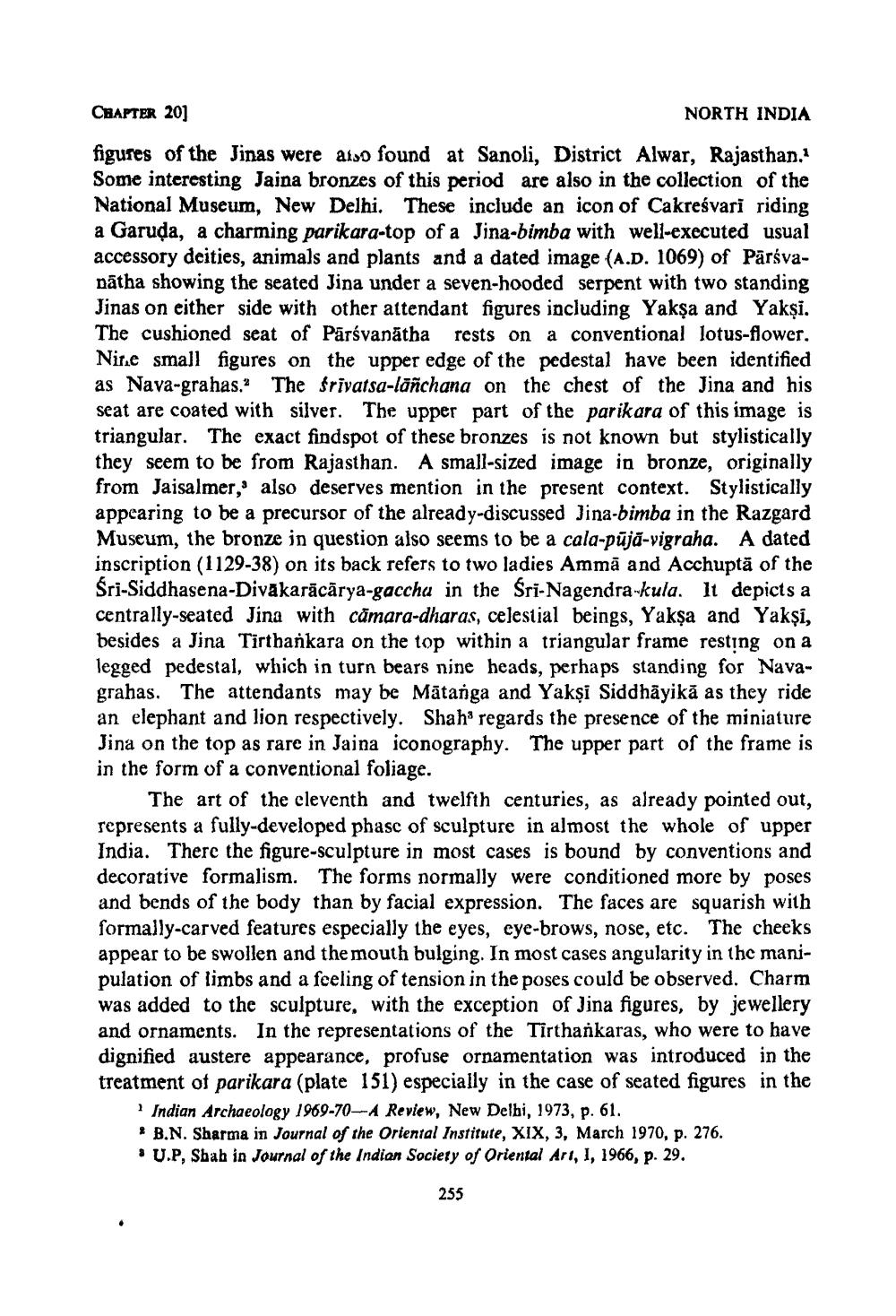________________
CHAPTER 20]
NORTH INDIA
figures of the Jinas were also found at Sanoli, District Alwar, Rajasthan. Some interesting Jaina bronzes of this period are also in the collection of the National Museum, New Delhi. These include an icon of Cakreśvari riding a Garuda, a charming parikara-top of a Jina-bimba with well-executed usual accessory deities, animals and plants and a dated image (A.D. 1069) of Pārsvanātha showing the seated Jina under a seven-hooded serpent with two standing Jinas on either side with other attendant figures including Yakşa and Yaksi. The cushioned seat of Pārsvanātha rests on a conventional lotus-flower. Nire small figures on the upper edge of the pedestal have been identified as Nava-grahas. The frivatsa-lāñchana on the chest of the Jina and his seat are coated with silver. The upper part of the parikara of this image is triangular. The exact findspot of these bronzes is not known but stylistically they seem to be from Rajasthan. A small-sized image in bronze, originally from Jaisalmer, also deserves mention in the present context. Stylistically appearing to be a precursor of the already-discussed Jina-bimba in the Razgard Museum, the bronze in question also seems to be a cala-pūjā-vigraha. A dated inscription (1129-38) on its back refers to two ladies Ammā and Acchuptă of the Sri-Siddhasena-Divakarācārya-gaccha in the Sri-Nagendra-kula. It depicts a centrally-seated Jina with câmara-dharas, celestial beings, Yakşa and Yaksi, besides a Jina Tirthankara on the top within a triangular frame resting on a legged pedestal, which in turn bears nine heads, perhaps standing for Navagrahas. The attendants may be Mātanga and Yakşi Siddhãyikā as they ride an elephant and lion respectively. Shah' regards the presence of the miniature Jina on the top as rare in Jaina iconography. The upper part of the frame is in the form of a conventional foliage.
The art of the cleventh and twelfth centuries, as already pointed out, represents a fully-developed phase of sculpture in almost the whole of upper India. There the figure-sculpture in most cases is bound by conventions and decorative formalism. The forms normally were conditioned more by poses and bends of the body than by facial expression. The faces are squarish with formally-carved features especially the eyes, eye-brows, nose, etc. The cheeks appear to be swollen and the mouth bulging. In most cases angularity in the manipulation of limbs and a feeling of tension in the poses could be observed. Charm was added to the sculpture, with the exception of Jina figures, by jewellery and ornaments. In the representations of the Tirtharkaras, who were to have dignified austere appearance, profuse ornamentation was introduced in the treatment of parikara (plate 151) especially in the case of seated figures in the
Indian Archaeology 1969-70--A Review, New Delhi, 1973, p. 61. * B.N. Sharma in Journal of the Oriental Institute, XIX, 3, March 1970, p. 276. • U.P, Shah in Journal of the Indian Society of Oriental Ari, I, 1966, p. 29.
255




